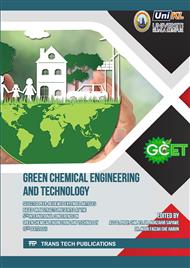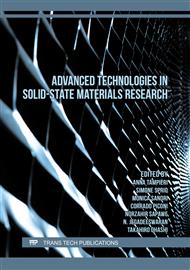[1]
R. Mu et al., Recent trends and applications of cellulose nanocrystals in food industry,, Trends Food Sci. Technol., vol. 93, p.136–144, (2019).
DOI: 10.1016/j.tifs.2019.09.013
Google Scholar
[2]
F. Eza Ria, A. Rizqi, and T. Hidayah, Uji Aktivitas Antioksidan Pada Kulit Jeruk Manis (Citrus Sinensis)Sebagai Alternatif Bahan Pembuatan Masker Wajah,, Pelita, vol. VI, no. 2, p.1–10, (2011).
Google Scholar
[3]
T. Zulchi and H. Puad, Keragaman Morfologi dan Kandungan Protein Kacang Tanah (Arachis hypogaea L.),, Bul. Plasma Nutfah, vol. 23, no. 2, p.91, (2018).
DOI: 10.21082/blpn.v23n2.2017.p91-100
Google Scholar
[4]
C. Brigham, Chapter 3.22 - Biopolymers: Biodegradable Alternatives to Traditional Plastics,, in Green Chemistry, B. Török and T. Dransfield, Eds. Elsevier, 2018, p.753–770.
Google Scholar
[5]
S. Durairaj, S. Srinivasan, and P. Lakshmanaperumalsamy, In vitro Antibacterial Activity and Stability of Garlic Extract at Different pH and Temperature,, e J Biol, vol. 6, (2010).
Google Scholar
[6]
M. A. F. Supian, K. N. M. Amin, S. S. Jamari, and S. Mohamad, Production of cellulose nanofiber (CNF) from empty fruit bunch (EFB) via mechanical method,, J. Environ. Chem. Eng., vol. 8, no. 1, p.103024, 2020, doi: https://doi.org/10.1016/j.jece.2019.103024.
DOI: 10.1016/j.jece.2019.103024
Google Scholar
[7]
C. Xu, G. Wang, C. Xing, L. Matuana, and H. Zhou, Effect of Graphene Oxide Treatment on the Properties of Cellulose Nanofibril Films Made of Banana Petiole Fibers,, BioResources, vol. 10, 2015,.
DOI: 10.15376/biores.10.2.2809-2822
Google Scholar
[8]
T. Chandrasekaran and K. Uppuluri, Isolation and characterization of cellulose nanocrystals from jackfruit peel,, Sci. Rep., vol. 9, p.16709, (2019).
DOI: 10.1038/s41598-019-53412-x
Google Scholar
[9]
N. Lani, N. Ngadi, A. Johari, and M. Jusoh, Isolation, Characterization, and Application of Nanocellulose from Oil Palm Empty Fruit Bunch Fiber as Nanocomposites,, J. Nanomater., vol. 2014, p.1–9, (2014).
DOI: 10.1155/2014/702538
Google Scholar
[10]
M. Abdollahi, M. Alboofetileh, R. Behrooz, M. Rezaei, and R. Miraki, Reducing water sensitivity of alginate bio-nanocomposite film using cellulose nanoparticles,, Int. J. Biol. Macromol., vol. 54, p.166–173, (2013).
DOI: 10.1016/j.ijbiomac.2012.12.016
Google Scholar
[11]
M. A. Sani, M. Tavassoli, H. Hamishehkar, and D. J. McClements, Carbohydrate-based films containing {pH}-sensitive red barberry anthocyanins: Application as biodegradable smart food packaging materials,, Carbohydr. Polym., vol. 255, p.117488, Mar. (2021).
DOI: 10.1016/j.carbpol.2020.117488
Google Scholar
[12]
N. Cebi, M. Abusurrah, and O. Sagdic, Detection of Orange Essential Oil, Isopropyl Myristate, and Benzyl Alcohol in Lemon Essential Oil by FTIR Spectroscopy Combined with Chemometrics,, Foods, vol. 10, p.27, (2020).
DOI: 10.3390/foods10010027
Google Scholar
[13]
E. Sogut, Active whey protein isolate films including bergamot oil emulsion stabilized by nanocellulose,, Food Packag. Shelf Life, vol. 23, p.100430, (2020).
DOI: 10.1016/j.fpsl.2019.100430
Google Scholar
[14]
Z. Yu, L. Sun, W. Wang, W. Zeng, A. Mustapha, and M. Lin, Soy protein-based films incorporated with cellulose nanocrystals and pine needle extract for active packaging,, Ind. Crops Prod., vol. 112, p.412–419, 2018, doi: https://doi.org/10.1016/j.indcrop.2017.12.031.
DOI: 10.1016/j.indcrop.2017.12.031
Google Scholar
[15]
L. Huang et al., Preparation and Properties of Cassava Residue Cellulose Nanofibril/Cassava Starch Composite Films,, Nanomaterials, vol. 10, no. 4, 2020,.
DOI: 10.3390/nano10040755
Google Scholar
[16]
B. Poyraz, A. Tozluoglu, Z. Candan, A. Demir, and M. Yavuz, Influence of PVA and silica on chemical, thermo-mechanical and electrical properties of Celluclast-treated nanofibrillated cellulose composites,, Int. J. Biol. Macromol., vol. 104, Jun. 2017,.
DOI: 10.1016/j.ijbiomac.2017.06.018
Google Scholar
[17]
C. K. Saurabh et al., Isolation and Characterization of Cellulose Nanofibers from Gigantochloa scortechinii as a Reinforcement Material,, J. Nanomater., vol. 2016, p.4024527, 2016,.
Google Scholar
[18]
A. González and C. I. Alvarez Igarzabal, Nanocrystal-reinforced soy protein films and their application as active packaging,, Food Hydrocoll., vol. 43, p.777–784, 2015, doi: https://doi.org/10.1016/j.foodhyd.2014.08.008.
DOI: 10.1016/j.foodhyd.2014.08.008
Google Scholar
[19]
Y. Shahbazi, The properties of chitosan and gelatin films incorporated with ethanolic red grape seed extract and Ziziphora clinopodioides essential oil as biodegradable materials for active food packaging,, Int. J. Biol. Macromol., vol. 99, p.746–753, 2017, doi: https://doi.org/10.1016/j.ijbiomac.2017.03.065.
DOI: 10.1016/j.ijbiomac.2017.03.065
Google Scholar



